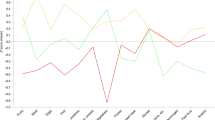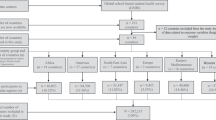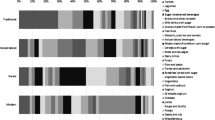Abstract
Background:
Dietary patterns, physical activity (PA) and sedentary behaviours are some of the main behavioural determinants of obesity; their combined influence in children has been addressed in a limited number of studies.
Subjects/Methods:
Children (16 228) aged 2–9 years old from eight European countries participated in the baseline survey of the IDEFICS study. A subsample of 11 674 children (50.8% males) were included in the present study. Children’s food and beverage consumption (fruit and vegetables (F&V) and sugar-sweetened beverages (SSBs)), PA and sedentary behaviours were assessed via parental questionnaires. Sex-specific cluster analysis was applied to identify behavioural clusters. Analysis of covariance and logistic regression were applied to examine the association between behavioural clusters and body composition indicators (BCIs).
Results:
Six behavioural clusters were identified (C1–C6) both in boys and girls. In both sexes, clusters characterised by high level of PA (C1 and C3) included a large proportion of older children, whereas clusters characterised by low SSB consumption (C5 and C6) included a large proportion of younger children. Significant associations between derived clusters and BCI were observed only in boys; those boys in the cluster with the highest time spent in sedentary activities and low PA had increased odds of having a body mass index z-score (odds ratio (OR)=1.33; 95% confidence interval (CI)=(1.01, 1.74)) and a waist circumference z-score (OR=1.41; 95%CI=(1.06, 1.86)) greater than one.
Conclusion:
Clusters characterised by high sedentary behaviour, low F&V and SSB consumption and low PA turned out to be the most obesogenic factors in this sample of European children.
This is a preview of subscription content, access via your institution
Access options
Subscribe to this journal
Receive 12 print issues and online access
$259.00 per year
only $21.58 per issue
Buy this article
- Purchase on Springer Link
- Instant access to full article PDF
Prices may be subject to local taxes which are calculated during checkout

Similar content being viewed by others
References
NIH Strategic Plan for National Institutes of Health Obesity Research: a Report of the NHI Obesity Task Force. NIH: Bethesda, MD, USA, 2011.
World Health Assembly Global Strategy on Diet and Physical Activity. World Health Organization: : Geneva, Switzerland, 2004.
Rey-Lopez JP, Vicente-Rodriguez G, Biosca M, Moreno LA . Sedentary behaviour and obesity development in children and adolescents. Nutr Metab Cardiovasc Dis 2008; 18: 242–251.
Moreno LA, Rodriguez G . Dietary risk factors for development of childhood obesity. Curr Opin Clin Nutr Metab Care 2007; 10: 336–341.
Janz KF, Burns TL, Levy SM . Tracking of activity and sedentary behaviors in childhood: the Iowa Bone Development Study. Am J Prev Med 2005; 29: 171–178.
Maffeis C . Aetiology of overweight and obesity in children and adolescents. Eur J Pediatr 2000; 159 (Suppl 1), S35–S44.
Boone-Heinonen J, Gordon-Larsen P, Adair LS . Obesogenic clusters: multidimensional adolescent obesity-related behaviors in the U.S. Ann Behav Med 2008; 36: 217–230.
Bel-Serrat S, Mouratidou T, Santaliestra-Pasias AM, Iacoviello L, Kourides YA, Marild S et al. Clustering of multiple lifestyle behaviours and its association to cardiovascular risk factors in children: the IDEFICS study. Eur J Clin Nutr 2013; 67: 848–854.
French S, Rosenberg M, Knuiman M . The clustering of health risk behaviours in a Western Australian adult population. Health Promot J Austr 2008; 19: 203–209.
Sabbe D, De Bourdeaudhuij I, Legiest E, Maes L . A cluster-analytical approach towards physical activity and eating habits among 10-year-old children. Health Educ Res 2008; 23: 753–762.
te Velde SJ, De Bourdeaudhuij I, Thorsdottir I, Rasmussen M, Hagstromer M, Klepp KI et al. Patterns in sedentary and exercise behaviors and associations with overweight in 9-14-year-old boys and girls—a cross-sectional study. BMC Public Health 2007; 7: 16.
Vries Hd, Kremers S, Smeets T, Reubsaet A . Clustering of diet, physical activity and smoking and a general willingness to change. Psychol Health 2008 2011/09/01 23: 265–278.
De Vries H, van 't Riet J, Spigt M, Metsemakers J, van den Akker M, Vermunt JK et al. Clusters of lifestyle behaviors: Results from the Dutch SMILE study. Prev Med 2008; 46: 203–208.
Cameron AJ, Crawford DA, Salmon J, Campbell K, McNaughton SA, Mishra GD et al. Clustering of obesity-related risk behaviors in children and their mothers. Ann Epidemiol 2011; 21: 95–102.
Ottevaere C, Huybrechts I, Benser J, De Bourdeaudhuij I, Cuenca-Garcia M, Dallongeville J et al. Clustering patterns of physical activity, sedentary and dietary behavior among European adolescents: The HELENA study. BMC Public Health 2011; 11: 328.
Ahrens W, Bammann K, de Henauw S, Halford J, Palou A, Pigeot I et al. Understanding and preventing childhood obesity and related disorders–IDEFICS: a European multilevel epidemiological approach. Nutr Metab Cardiovasc Dis 2006; 16: 302–308.
Ahrens W, Bammann K, Siani A, Buchecker K, De Henauw S, Iacoviello L et al. The IDEFICS cohort: design, characteristics and participation in the baseline survey. Int J Obes (Lond) 2011; 35: S3–15.
Bammann K, Peplies J, Sjöström M, Lissner L, De Henauw S, Galli C et al. Assessment of diet, physical activity and biological, social and environmental factors in a multi-centre European project on diet- and lifestyle-related disorders in children (IDEFICS). J Public Health 2006; 14: 279–289.
United Nations Educational Scientific and Cultural Organization International Standard Classitication of Education 2010 (April 2012). Available at: http://www.uis.unesco.org/Education/Pages/international-standard-classification-of-education.aspx.
Lanfer A, Hebestreit A, Ahrens W, Krogh V, Sieri S, Lissner L et al. Reproducibility of food consumption frequencies derived from the Children's Eating Habits Questionnaire used in the IDEFICS study. Int J Obes (Lond) 2011; 35 (Suppl 1), S61–S68.
Huybrechts I, Bornhorst C, Pala V, Moreno LA, Barba G, Lissner L et al. Evaluation of the Children's Eating Habits Questionnaire used in the IDEFICS study by relating urinary calcium and potassium to milk consumption frequencies among European children. Int J Obes (Lond) 2011; 35 (Suppl 1), S69–S78.
Bel-Serrat S, Mouratidou T, Pala V, Huybrechts I, Bornhorst C, Fernandez-Alvira JM et al. Relative validity of the Children's Eating Habits Questionnaire-food frequency section among young European children: the IDEFICS Study. Public Health Nutr 2014; 17: 1–11.
Santaliestra-Pasias AM, Mouratidou T, Verbestel V, Bammann K, Molnar D, Sieri S et al. Physical activity and sedentary behaviour in European children: the IDEFICS study. Public Health Nutr 2013; 8: 1–12.
Kaiser Family Foundation Generation M: Media in the Lives of 8-18-year-olds. The Henry J Kaser Family Foundation, 2010. Available at http://kff.org/entmedia/mh012010pkg.cfm.
Verbestel V, De Henauw S, Bammann K, Barba G, Hadjigeorgiou C, Eiben G et al. Are context-specific measures of parental-reported physical activity and sedentary behaviour associated with accelerometer data in 2-9-year-old European children? Public Health Nutr 2014; 18: 1–9.
Bammann K, Sioen I, Huybrechts I, Casajus JA, Vicente-Rodriguez G, Cuthill R et al. The IDEFICS validation study on field methods for assessing physical activity and body composition in children: design and data collection. Int J Obes (Lond) 2011; 35 (Suppl 1), S79–S87.
Stomfai S, Ahrens W, Bammann K, Kovacs E, Marild S, Michels N et al. Intra- and inter-observer reliability in anthropometric measurements in children. Int J Obes (Lond) 2011; 35 (Suppl 1), S45–S51.
Gore PA . Cluster analysis. Tinsley HEA, Brown SD (eds) Handbook of Applied Multivariate Statistics and Mathematical Modeling. Academic Press: : San Diego, CA, USA, 2000; 297–321.
Viera AJ, Garrett JM . Understanding interobserver agreement: the kappa statistic. Fam Med 2005; 37: 360–363.
De Henauw S, Verbestel V, Marild S, Barba G, Bammann K, Eiben G et al. The IDEFICS community-oriented intervention programme: a new model for childhood obesity prevention in Europe? Int J Obes (Lond) 2011; 35 (Suppl 1), S16–S23.
Fruit and Vegetable Promotion Initiative—Report of the Meeting. World Health Organization: : Geneva, Switzerland, 2003.
Agostoni C, Braegger C, Decsi T, Kolacek S, Koletzko B, Mihatsch W et al. Role of dietary factors and food habits in the development of childhood obesity: a commentary by the ESPGHAN Committee on Nutrition. J Pediatr Gastroenterol Nutr 2011; 52: 662–669.
Kovacs E, Siani A, Konstabel K, Hadjigeorgiou C, De Bourdeaudhuij I, Eiben G et al. Adherence to the obesity-related lifestyle intervention targets in the IDEFICS study. Int J Obes 2014; 38: S144–S151.
Naska A, Bountziouka V, Trichopoulou A . Soft drinks: time trends and correlates in twenty-four European countries. A cross-national study using the DAFNE (Data Food Networking) databank. Public Health Nutr 2010; 13: 1346–1355.
Popkin BM . Patterns of beverage use across the lifecycle. Physiol Behav 2010; 100: 4–9.
Duffey KJ, Huybrechts I, Mouratidou T, Libuda L, Kersting M, De Vriendt T et al. Beverage consumption among European adolescents in the HELENA study. Eur J Clin Nutr 2011; 66: 244–252.
American Academy of Pediatrics. Committee on Public Education.. American Academy of Pediatrics: Children, adolescents, and television. Pediatrics 2001; 107: 423–426.
U.S. Department of Health and Human Services 2008 Physical Activity Guidelines for Americans. U.S. Department of Health and Human Services: Washington DC, USA, 2008.
Landsberg B, Plachta-Danielzik S, Lange D, Johannsen M, Seiberl J, Muller MJ . Clustering of lifestyle factors and association with overweight in adolescents of the Kiel Obesity Prevention Study. Public Health Nutr 2010; 13: 1708–1715.
De Bourdeaudhuij I, van Oost P . A cluster-analytical approach toward physical activity and other health related behaviors. Med Sci Sports Exerc 1999; 31: 605–612.
Santaliestra-Pasías AM, Mouratidou T, Verbestel V, Huybrechts I, Gottrand F, Le Donne C et al. Food consumption and screen-based sedentary behaviors in European adolescents: the HELENA study. Arch Pediatr Adolesc Med 2012; 166: 1010–1020.
Proctor MH, Moore LL, Gao D, Cupples LA, Bradlee ML, Hood MY et al. Television viewing and change in body fat from preschool to early adolescence: the Framingham Children's Study. Int J Obes Relat Metab Disord 2003; 27: 827–833.
Mouratidou T, Mesana MI, Manios Y, Koletzko B, Chinapaw MJ, De Bourdeaudhuij I et al. Assessment tools of energy balance-related behaviours used in European obesity prevention strategies: review of studies during preschool. Obes Rev 2012; 13 (Suppl 1), 42–55.
Acknowledgements
We thank all members of the study teams and especially the children and their parents for their participation in the study. This work was carried out as part of the IDEFICS Study and is published on behalf of its European Consortium (www.idefics.eu). We gratefully acknowledge the financial support of the European Community within the Sixth RTD Framework Program, Contract No. 016181 (FOOD). In addition, AMS-P received financial support by Fundación Cuenca Villoro (Spain), and was partially supported by grants from the Spanish Carlos III Health Institute: RD12/0026/0009 (Red SAMID: Maternal, Child Health and Development Research Network). The information in this document reflects the authors’ view and is provided as it is. No guarantee or warranty is given that the information is fit for any particular purpose. The reader, therefore, uses the information at its sole risk and liability.
Author information
Authors and Affiliations
Corresponding author
Ethics declarations
Competing interests
The authors declare no conflict of interest.
Additional information
Supplementary Information accompanies this paper on European Journal of Clinical Nutrition website
Supplementary information
Rights and permissions
About this article
Cite this article
Santaliestra-Pasías, A., Mouratidou, T., Reisch, L. et al. Clustering of lifestyle behaviours and relation to body composition in European children. The IDEFICS study. Eur J Clin Nutr 69, 811–816 (2015). https://doi.org/10.1038/ejcn.2015.76
Received:
Revised:
Accepted:
Published:
Issue Date:
DOI: https://doi.org/10.1038/ejcn.2015.76
This article is cited by
-
Clustering of diet, physical activity and sedentary behaviour and related physical and mental health outcomes: a systematic review
BMC Public Health (2023)
-
Clustering of lifestyle behaviors and adiposity in early adolescents in Spain: findings from the SI! Program for Secondary Schools
BMC Public Health (2023)
-
Lifestyle behaviors clusters in a nationwide sample of Spanish children and adolescents: PASOS study
Pediatric Research (2023)
-
Total urinary polyphenols and ideal cardiovascular health metrics in Spanish adolescents enrolled in the SI Program: a cross-sectional study
Scientific Reports (2022)
-
Eating behaviour, physical activity, TV exposure and sleeping habits in five year olds: a latent class analysis
BMC Pediatrics (2021)



